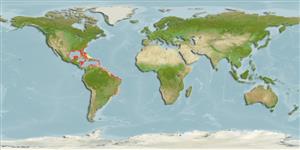Environment: milieu / climate zone / depth range / distribution range
Sinh thái học
Biển Cùng sống ở rạn san hô; Mức độ sâu 1 - 100 m (Ref. 128874), usually 3 - 30 m (Ref. 128874). Tropical; 38°N - 33°S, 98°W - 34°W
Western Atlantic: from Virginia and the Gulf of Mexico to Cuba and Puerto Rico (Central Caribbean), and to Colombia (northern South America).
Bộ gần gũi / Khối lượng (Trọng lượng) / Age
Maturity: Lm ? range ? - ? cm
Max length : 23.0 cm TL con đực/không giới tính; (Ref. 7251); common length : 18.0 cm TL con đực/không giới tính; (Ref. 5217)
Các tia vây lưng cứng (tổng cộng) : 9 - 11; Các vây lưng mềm (tổng cộng) : 36 - 40; Tia cứng vây hậu môn: 2; Tia mềm vây hậu môn: 7. This species is distinguished from its congeners in the western Atlantic by the following characters: lateral line pored scales 44-49; scales above lateral line 6 and below 8; straight white stripes 8, usually wider than black stripes on sides; chin with 5 pores. Colouration: submarginal white stripe on soft dorsal fin, no dark bar between eyes, body with 3-5 broad dark horizontal stripes and narrow stripes in between, no wide transverse dark bar from dorsal-fin origin almost to pelvic-fin base (Ref. 128874).
Occurs in clear waters of tropical islands, especially near coral reefs, but also in adjacent bays over rough bottom. Also often found under eroded edges of seagrass beds (Ref. 26938). Juveniles of about the same age, often in groups of 3-7, were observed in very shallow water under ledges or near sand pockets close to reef crevices, The young are usually found in small groups of the same age, in very shallow water under ledges or near sand pockets close to reef crevices,but may also be found in deeper water. Adults occurs among rocks, under ledges, inside caves and, eventually in the open. The species is mainly nocturnal, spending the day sheltered and feeding at night on sand, mud, and rubble bottoms close to the reef, feeding on crustaceans, polychaetes, small bony fishes, and zooplankton (Ref. 128874). Has been reared in captivity (Ref. 35420).
Life cycle and mating behavior
Maturities | Sự tái sinh sản | Spawnings | Egg(s) | Fecundities | Ấu trùng
Carvalho-Filho, A., C. Oliveira, L. Maximiano, J. Tavera, A.P. Acero and A.P. Marceniuk, 2022. Review of the Pareques acuminatus (Bloch & Schneider, 1801) species complex, with revalidation of Pareques lineatus (Cuvier, 1830) from the Western Atlantic (Percomorphacea: Sciaenidae). Zootaxa 5195(5):401-418. (Ref. 128874)
IUCN Red List Status (Ref. 130435)
Threat to humans
Harmless
Human uses
Các nghề cá: buôn bán nhỏ; Bể nuôi cá: Tính thương mại
Các công cụ
Special reports
Download XML
Các nguồn internet
Estimates based on models
Preferred temperature (Ref.
123201): 22.9 - 28, mean 25.9 °C (based on 454 cells).
Phylogenetic diversity index (Ref.
82804): PD
50 = 0.5078 [Uniqueness, from 0.5 = low to 2.0 = high].
Bayesian length-weight: a=0.00977 (0.00576 - 0.01657), b=3.12 (2.98 - 3.26), in cm total length, based on LWR estimates for this species & (Sub)family-body (Ref.
93245).
Mức dinh dưỡng (Ref.
69278): 3.6 ±0.5 se; based on diet studies.
Thích nghi nhanh (Ref.
120179): Chiêù cao, thời gian nhân đôi của chủng quần tối thiểu là dưới 15 tháng (Preliminary K or Fecundity.).
Fishing Vulnerability (Ref.
59153): Low vulnerability (13 of 100).
Nutrients (Ref.
124155): Calcium = 75.9 [39.2, 126.0] mg/100g; Iron = 0.69 [0.35, 1.16] mg/100g; Protein = 19.6 [18.3, 20.9] %; Omega3 = 0.153 [0.083, 0.233] g/100g; Selenium = 32.4 [18.9, 59.9] μg/100g; VitaminA = 84.5 [28.3, 283.8] μg/100g; Zinc = 1.32 [0.92, 1.88] mg/100g (wet weight);
